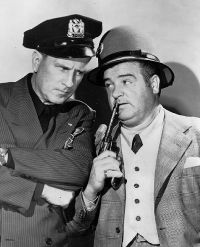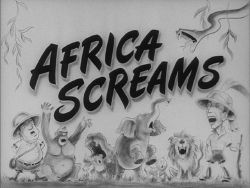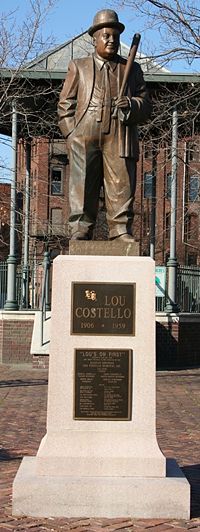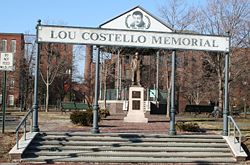Abbott and Costello
Abbott and Costello was an American comedy duo composed of Bud Abbott and Lou Costello. Their work in radio, film, and television made them the most popular comedy team during the 1940s.
Masters of the straightman/clown relationship, they achieved national recognition by performing vaudeville routines. Their classic baseball routine called "Who's On First?" became synonymous with the pair and a recording was sent to the Baseball Hall of Fame in 1956. It was also chosen as the routine of the millennium by Time. An early radio recording of the routine was placed in the Library of Congress' National Recording Archives in 2003. In 2005, the line "Who's On First?" was included among the American Film Institute's list of 100 memorable movie quotes.
Abbot and Costello have been named “Legendary Performers” by the Smithsonian Institution and are part of their permanent collection. In 1993 cable networks began airing a steady stream of Abbott & Costello films. Comedian Jerry Seinfeld hosted a 10-hour Abbott and Costello Comedy Marathon on the Comedy Channel Network. Their clean style of comedy continues to find a large audience in the modern marketplace.
The Burlesque Years
William Alexander Abbott was a veteran burlesque entertainer from a show business family. He had worked at Coney Island and ran his own burlesque touring companies. At first he worked as a straight man to his wife Betty, then with veteran burlesque comedians like Harry Steppe and Harry Evanson. When he met his future partner in comedy, Abbott was performing in Minsky's burlesque shows.
Lou Costello (born Louis Francis Cristillo) had been a burlesque comic since 1930, after failing to break into movie acting and working as a stunt double and film extra. He appears briefly in the 1927 Laurel and Hardy silent two-reeler, The Battle of the Century, seated at ringside during Stan's ill-fated boxing match. As a teenager, Costello had been an amateur boxer in his hometown of Paterson, New Jersey.
The two first worked together in 1935 at the Eltinge Burlesque Theater on 42nd Street in New York City.[1] Other performers in the show, including Abbott's wife, advised a permanent pairing with Costello. The duo built an act by refining and reworking numerous burlesque sketches into the long-familiar presence of Abbott as the devious straight man, and Costello as the stumbling, dimwitted laugh-getter.
Fame
The team's first known radio appearance was on The Kate Smith Hour in February, 1938. "Who's on First?" was first performed for a national radio audience the following month.[1] Abbott and Costello stayed on the program as regulars for two years, but the similarities between their New Jersey-accented voices made it difficult for listeners (as opposed to stage audiences) to tell them apart due to their rapid-fire repartee. The problem was solved by having Costello affect a high-pitched childish voice, and their remaining tenure on the Smith show was successful enough to get them roles in a Broadway revue "The Streets of Paris" in 1939.
In 1940 they were signed by Universal Studios for the film One Night in the Tropics. Cast in supporting roles, they stole the show with several classic routines, including "Who's on First?" The same year they were a summer replacement on radio for Fred Allen. Two years later, they had their own NBC show.
Universal signed them to a long-term contract, and their second film, Buck Privates, (1941) made them box-office stars. They made over 30 films between 1940 and 1956. Abbott and Costello were among the most popular and highest-paid entertainers during World War II. Other film successes included Hold That Ghost, Who Done It?, Pardon My Sarong, The Time of Their Lives, Buck Privates Come Home,, Abbott and Costello Meet Frankenstein, and Abbott and Costello Meet the Invisible Man.
In 1942, Abbott and Costello were the top box office draw with a reported take of $10 million. They would remain a top ten box office attraction until 1952.
Their brand of comedy helped lift the morale of the American public during World War II. Eager to lend their time to the war effort they funded (out of pocket) a cross-country tour to help raise much-needed funds on behalf of the War Bond Drive. Everywhere they appeared there were sellout audiences. They were honored on the steps of New York's City Hall by Mayor Fiorello LaGuardia for raising a record-breaking $89 million in three days.[2]
Radio
After working as Allen's summer replacement, Abbott and Costello joined Edgar Bergen and Charlie McCarthy on The Chase and Sanborn Hour in 1941, while two of their films (Buck Privates and Hold That Ghost) were adapted for Lux Radio Theater. They launched their own weekly show October 8, 1942, sponsored by Camel cigarettes.
The Abbott and Costello Show mixed comedy with musical interludes (by vocalists such as Connie Haines, Ashley Eustis, the Delta Rhythm Boys, Skinnay Ennis, and the Les Baxter Singers). Regulars and semi-regulars on the show included Artie Auerbach ("Mr. Kitzel"), Elvia Allman, Iris Adrian, Mel Blanc, Wally Brown, Sharon Douglas, Verna Felton, Sidney Fields, Frank Nelson, Martha Wentworth, and Benay Venuta.
Ken Niles was the show's longtime announcer, doubling as an exasperated foil to Abbott and Costello's mishaps (and often fuming in character as Costello routinely insulted his on-air wife). Niles was succeeded by Michael Roy, with announcing chores also handled over the years by Frank Bingman and Jim Doyle. The show went through several orchestras during its radio life, including those of Ennis, Charles Hoff, Matty Matlock, Jack Meakin, Will Osborne, Freddie Rich, Leith Stevens, and Peter van Steeden. The show's writers included Howard Harris, Hal Fimberg, Parke Levy, Don Prindle, Eddie Cherkose (later known as Eddie Maxwell), Leonard Stern, Martin Ragaway, Paul Conlan, and Eddie Forman, as well as producer Martin Gosch. Sound effects were handled primarily by Floyd Caton.
In 1947 Abbott and Costello moved the show to ABC (the former NBC Blue Network). During their time on ABC, the duo also hosted a 30-minute children's radio program (The Abbott and Costello Children's Show), which aired Saturday mornings, featuring child vocalist Anna Mae Slaughter and child announcer Johnny McGovern.
Television
In 1951, they moved to television as rotating hosts of The Colgate Comedy Hour. (Eddie Cantor and Martin and Lewis were among the others.) Each show was a live hour of vaudeville in front of a theater audience, revitalizing the comedians' performances and giving their old routines a new sparkle.
Beginning in 1952, a filmed half-hour series, The Abbott and Costello Show, appeared in syndication on local stations across the county. Loosely based on their radio series, the show cast the duo as unemployed wastrels. One of the show's running gags involved Abbott perpetually nagging Costello to get a job to pay their rent, while Abbott barely lifted a finger in that direction. The show featured Sidney Fields as their landlord, and Hillary Brooke as a friendly neighbor who sometimes got involved in the pair's schemes. Another semi-regular was Joe Besser as Stinky, a 40-year-old sissy dressed in a Little Lord Fauntleroy suit. Gordon Jones was Mike the cop, who always lost patience with Lou. The Abbott and Costello Show ran two seasons, but found a larger viewership in reruns from the late 1960s to the 1990s. In 2006 the shows were released in two five-DVD sets.
Private lives
Both Abbott and Costello met and married women they knew in burlesque. Bud Abbott married Betty Smith in 1918, and Lou Costello married Anne Battler in 1934. The Costellos had four children; the Abbotts adopted two.
Abbott and Costello faced personal demons at times. Both were inveterate gamblers and had serious health problems.
Abbott suffered from epilepsy and turned to alcohol for pain management.
Costello had occasional, near-fatal bouts with rheumatic fever. On November 4, 1943, the same day that Costello returned to radio after a one year layoff due to his illness with rheumatic fever, his infant son "Butch" (born November 6, 1942) died in an accidental drowning in the family's swimming pool.[3]
During 1945, a rift developed when Abbott hired a domestic servant who had been fired by Costello. Stung by Abbott's move, Costello refused to speak to his partner except when performing. The team's films of 1946 reflect the split, with the comedians appearing separately in character roles. Abbott resolved the rift in 1947 when he volunteered to help with Costello's pet charity, a foundation for underprivileged children.
Later years
In the 1950s Abbott and Costello's popularity waned as their place as filmdom's hottest comedy team was taken by Martin and Lewis. Another reason for the decline was overexposure. Abbott and Costello's routines, already familiar, were now glutting the movie and television markets. Each year they made two new films, while Realart Pictures re-released most of their older hits; their filmed television series was widely syndicated, and they did the same routines frequently on the Colgate program. (Writer Parke Levy told Jordan R. Young, in The Laugh Crafters: Comedy Writing in Radio and TV's Golden Age, that he was stunned to learn that Bud and Lou were afraid to perform new material.) Universal dropped the comedy team in 1955, and after one more independent film, Bud Abbott retired from performing.
In 1956, the Internal Revenue Service charged them for back taxes, forcing them to sell their homes and most of their assets, including their film rights. In 1957 they formally dissolved their partnership.
Lou Costello made about ten solo appearances on The Steve Allen Show and headlined in Las Vegas. He appeared in episodes of GE Theater and Wagon Train.
On March 3, 1959, shortly after making his lone solo film, The 30 Foot Bride of Candy Rock, Lou Costello died of a heart attack just short of his 53rd birthday.
Bud Abbott attempted a comeback in 1960, teaming with Candy Candido. Although the new act received good reviews, Bud quit, saying, "No one could ever live up to Lou." A serious weakness of the new act was that it copied the old act. Abbott and Candido simply reprised old Abbott & Costello routines, with Candido blatantly imitating Costello. Candido would then do a comedic monologue in his own persona while Abbott took a break backstage, then the finale consisted of both men performing the classic "Who's on First?" routine.
Abbott made a solo appearance on an episode of GE Theater in 1961. In 1966 he voiced his character in a series of 156 five-minute Abbott and Costello cartoons made by Hanna-Barbera. Costello's character was voiced by Stan Irwin.
Bud Abbott died of cancer on April 24, 1974.
Legacy
During the height of their popularity in the 1940s, Warner Bros.'s Looney Tunes/Merrie Melodies animation unit produced several cartoons featuring the pair as cats or mice named "Babbit and Catstello." One of the cartoons, "A Tale of Two Kitties," introduced one of the most enduring characters in the history of animation—Tweety Bird. The other cartoon was "A Tale of Two Mice." In both cartoons, Tedd Pierce and Mel Blanc, respectively, provide voice impressions of the comedy duo.
The revival of their former television series in syndicated reruns in the late 1960s and early 1970s helped spark renewed interest in the duo, as did the televising of many of their old film hits. In 1989, Bud and Lou's families released a compilation video of their appearances on the Colgate Comedy Hour in The Best of Abbott and Costello—Live. The video was nominated for two prestigious video awards in 1990, and in 1991 The Disney Channel did six special airings of the video.
In 1991, the United States Postal Service paid homage to the team by enlisting them as part of their "Comedy Legends" commemorative stamp booklet.
In 1994, comedian Jerry Seinfeld hosted a Thanksgiving television special Abbott and Costello meet Jerry Seinfeld (the title refers to the duo's popular film series in which they met some of Universal's famed horror picture characters), on NBC. Seinfeld has always acknowledged that The Abbott and Costello Show was an inspiration for his own popular series.
"Who's on First?" is believed to be available in as many as 20 versions; Abbott and Costello performed subtle variations of the routine in film, on their radio show, and on television (in one of their Colgate Comedy Hour installments and their half-hour TV series). Perhaps the most successful of the routines "Who's on First?" spawned was "Hertz U-Drive," about renting a car. On one of their radio broadcasts, the duo preceded yet another version of "Who's on First?" with a similar routine hooked around Cleveland Indians Hall of Fame pitcher Bob Feller.
The comedy duo was inducted into the New Jersey Hall of Fame on February 2, 2009.
Cultural references
In the 1988 movie Rain Man, Dustin Hoffman's autistic character Raymond Babbitt recites an affectless "Who's On First" as a defense mechanism when others become upset with him or something does not go his way.
NBC's Studio 60 on the Sunset Strip (2006), a drama about life backstage at a television comedy series, used "Who's on First?" as a plot device when the parents of cast member Tom Jeter (Nate Corddry) visit from Ohio, and he gives them a tour of the theater. However, they have little understanding of comedy and have never heard of "Who's on First?" In an attempt to relate to his parents just before they begin the long drive back to Ohio, Tom gives them a recording of "Who's on First?," which (according to the show's mythology) was first performed in the Addison Theater—the august building which later became Studio 60.
In the comedy film Robin Hood: Men in Tights, an Abbot, played by Dick Van Patten, walks down the aisle prior to a wedding, and someone in the crowd screams out "Hey, Abbot!," much like Lou Costello.
An episode of the Veggie Tales children's show, "Duke and the Great Pie War," features a character named The Abbot of Costello who tests two of the characters using a modified "Who's On First?" routine.
An episode of Animaniacs featured the characters of Skippy and Aunt Slappy doing a version of the skit at Woodstock, instead using the band names of The Who, The Band, and Yes instead of the names "Who," "What" and "I Don't Know."
Harvey Korman (Bud) and Buddy Hackett (Lou) portrayed the duo in a 1978 NBC television movie on the team.
In the first season of The West Wing in the episode He Shall, from Time To Time…, White House Chief of Staff Leo McGarry refers to Sam Seaborn and Josh Lyman as 'Abbott and Costello'.
"The Abbott and Costello Show" was a catchphrase occasionally used when referring to the Australian government of John Howard due to the names of two prominent members of the cabinet: Federal health minister Tony Abbott and federal treasurer Peter Costello.
Filmography
| Year | Movie | Lou Costello Role | Bud Abbott Role | Notes |
|---|---|---|---|---|
| 1940 | One Night in the Tropics | Costello | Abbott | Film Debut |
| 1941 | Buck Privates | Herbie Brown | Slicker Smith | |
| 1941 | In the Navy | Pomeroy Watson | Smokey Adams | |
| 1941 | Hold That Ghost | Ferdinand Jones | Chuck Murray | |
| 1941 | Keep 'Em Flying | Heathcliffe | Blackie Benson | |
| 1942 | Ride 'Em Cowboy | Willoughby | Duke | |
| 1942 | Rio Rita | Wishy Dunn | Doc | |
| 1942 | Pardon My Sarong | Wellington Phlug | Algy Shaw | |
| 1942 | Who Done It? | Mervyn Milgrim | Chick Larkin | |
| 1943 | It Ain't Hay | Wilbur Hoolihan | Grover Mickridge | |
| 1943 | Hit The Ice | Tubby McCoy | Flash Fulton | |
| 1944 | In Society | Albert Mansfield | Eddie Harrington | |
| 1944 | Lost in a Harem | Harvey Garvey | Peter Johnson | |
| 1945 | Here Come The Co-Eds | Oliver Quackenbush | Slats McCarthy | |
| 1945 | The Naughty Nineties | Sebastian Dinwiddie | Dexter Broadhurst | |
| 1945 | Abbott and Costello in Hollywood | Abercrombie | Buzz Kurtis | |
| 1946 | Little Giant | Benny Miller | John Morrison/Tom Chandler | |
| 1946 | The Time of Their Lives | Horatio Prim | Cuthbert/Dr. Greenway | |
| 1947 | Buck Privates Come Home | Herbie Brown | Slicker Smith | Sequel to Buck Privates |
| 1947 | The Wistful Widow of Wagon Gap | Chester Wooley | Duke Egan | |
| 1948 | The Noose Hangs High | Tommy Hinchcliffe | Ted Higgins | |
| 1948 | Abbott and Costello Meet Frankenstein | Wilbur Gray | Chick Young | |
| 1948 | Mexican Hayride | Joe Bascom/Humphrey Fish | Harry Lambert | |
| 1949 | Africa Screams | Stanley Livington | Buzz Johnson | |
| 1949 | Abbott and Costello Meet the Killer, Boris Karloff | Freddie Phillips | Casey Edwards | |
| 1950 | Abbott and Costello in the Foreign Legion | Lou Hotchkiss | Bud Jones | |
| 1951 | Abbott and Costello Meet the Invisible Man | Lou Francis | Bud Alexander | |
| 1951 | Comin' Round The Mountain | Wilbert | Al Stewart | |
| 1952 | Jack and the Beanstalk | Jack | Mr. Dinklepuss | |
| 1952 | Lost in Alaska | George Bell | Tom Watson | |
| 1952 | Abbott and Costello Meet Captain Kidd | Oliver "Puddin' Head" Johnson | Rocky Stonebridge | |
| 1953 | Abbott and Costello Go to Mars | Orville | Lester | |
| 1953 | Abbott and Costello Meet Dr. Jekyll and Mr. Hyde | Tubby | Slim | |
| 1955 | Abbott and Costello Meet the Keystone Kops | Willie Piper | Harry Pierce | |
| 1955 | Abbott and Costello Meet the Mummy | Costello (erroneously listed in the film as "Freddie Franklin" | Abbott (erroneously listed in the film as "Pete Patterson") | |
| 1956 | Dance with Me, Henry! | Lou Henry | Bud Flick | |
| 1959 | The 30-Foot Bride of Candy Rock | Artie Pinsetter | - | Lou Costello only. |
| 1965 | The World of Abbott and Costello | - | - | Compilation film |
Notes
- ↑ 1.0 1.1 Bob Furmanek and Ron Palumbo, Abbott and Costello in Hollywood (New York: Perigee, 1991, ISBN 0399516050).
- ↑ Abbott & Costello Biography Abbottandcostello.net. Retrieved December 21, 2017.
- ↑ Chris Costello, Lou's on First: The Tragic Life of Hollywood's Greatest Clown Warmly Recounted by his Youngest Child (New York: St. Martin's Griffin, 1982, ISBN 0312499140).
ReferencesISBN links support NWE through referral fees
- Costello, Chris. Lou's on First: The Tragic Life of Hollywood's Greatest Clown Warmly Recounted by his Youngest Child. New York: St. Martin's Griffin, 1982. ISBN 0312499140
- Dunning, John, On the Air: The Encyclopedia of Old-Time Radio. New York: Oxford University EPress, 1998. ISBN 0195076788
- Furmanek, Bob and Ron Palumbo. Abbott and Costello in Hollywood. New York: Perigee, 1991. ISBN 0399516050
- Mulholland, Jim. The Abbott and Costello Book. New York: Popular Library, 1977. ISBN 0445041382
External links
All links retrieved December 29, 2017.
- Abbott and Costello Meet the Internet Abbottandcostello.net.
- Fan Club Abbottandcostellofanclub.com.
- Bud Abbott Imbd.com.
- Lou Costello Imbd.com.
- Abbott and Costello Radiohof.org
- Who's on First? by Abbott and Costello Baseball-almanac.com.
- OTR Network Library: Abbott and Costello (44 episodes) Otr.net.
Credits
New World Encyclopedia writers and editors rewrote and completed the Wikipedia article in accordance with New World Encyclopedia standards. This article abides by terms of the Creative Commons CC-by-sa 3.0 License (CC-by-sa), which may be used and disseminated with proper attribution. Credit is due under the terms of this license that can reference both the New World Encyclopedia contributors and the selfless volunteer contributors of the Wikimedia Foundation. To cite this article click here for a list of acceptable citing formats.The history of earlier contributions by wikipedians is accessible to researchers here:
The history of this article since it was imported to New World Encyclopedia:
Note: Some restrictions may apply to use of individual images which are separately licensed.



